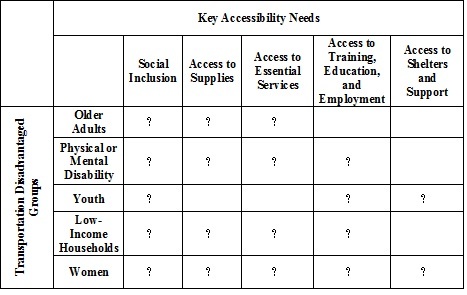by Eric Marr, 14/10/2012
“Everything in life is somewhere else, and you get there in a car” (E. B. White, 1940).
Nowhere is this statement more true than in rural areas. Throughout much of Canada a personal vehicle is the only transportation option available thereby severely restricting the mobility of those that cannot drive for any one of a multitude of reasons. Particularly in rural areas where transportation alternatives are rare those residents who do not have reliable access to a personal vehicle in order to access quality of life essentials are put at great risk of transportation disadvantage. This post represents Part 1 of 2 presenting the findings of a research project entitled “Assessing Transportation Disadvantage and Public Transportation Opportunities in Rural Ontario: A Case Study of Huron County”.
The purpose of this research was to assess the ability of rural residents that lack access to an automobile to reach the services and activities they require. A review of the literature identified 5 demographic groups residing in rural areas which are generally found to be at risk of having limited or no access to mobility. These groups were: older adults, youth, those with physical or mental disabilities, low-income individuals, and women. Correspondingly, the literature identified 5 accessibility needs that rural residents must be able to reach in order to maintain quality of life: social inclusion opportunities; access to supplies (i.e. food); access to essential services (i.e. health); access to training, education, and employment; and access to shelters and support (i.e. domestic abuse shelters).
The mobility limitations of these demographic groups were then compared with their accessibility needs to form a framework which may be applied to a rural community in order to determine what unmet transportation needs existed. This was tested within the context of Huron County, Ontario, Canada. In the end it was found that certain groups were at risk of transportation disadvantage in Huron County and were unable to reach the accessibility needs they required.
However, it was not as clear cut as one might expect. For instance, in the case of older adults, specialized transportation was available and affordable (through subsidized fares) for a wide range of purposes whereas for youth very few transportation options were available. The variation continues through the groups with specialized transportation being available for specific groups or purposes, but not others. Therefore, a key finding of this research was that transportation disadvantage exists on a continuum WITHIN demographic groups as well as BETWEEN groups depending on what is attempting to be reached.
Another key finding that emerged through this research was that transportation needs assessments must look beyond whether transportation is available and instead consider four distinct elements: affordability, accessibility, acceptability, AND availability. Too often I believe we consider whether transportation is available without consideration of whether it is adequate.
Finally, the finding I think is most interesting for the context of Huron County is that service providers (health services, financial assistance, foodbanks, education, etc.) were already spending a considerable amount of human and financial resources transporting their clients without considering themselves to be transportation providers. In fact, when setting up my interviews some participants told me that they were not in the business of transportation and they did not understand why I would want to talk to them. Nevertheless, once we got talking about the details of their service it became clear in several cases that they were providing ad hoc transportation on an as needed basis. For example, a common story was that service providers would pick up or drive clients to appointments if they did not have a ride, but they would not advertise that this service exists.
In the end, it was found that a considerable amount of human and financial resources were already being spent on informal transportation for those in need. This begs the question of how much, in monetary terms as well as time, is actually being spent on transportation and what could be achieved if these resources were pooled into a coordinated, generally available, public transportation service?
This finding also has important policy implications. Indeed, everyone is quite aware that public budgets are tight right now and in Ontario (much like elsewhere in the OECD) governments are reluctant to fund new programs; especially in light of difficulties funding existing services. Therefore, the finding that significant resources are already being spent may suggest that a rural transportation service could be funded through existing resources without a large amount of new funding being committed.
To conclude, this posting presents Part 1 of 2 looking at unmet transportation needs in rural Ontario. So what can be done about this issue? Part 2 will attempt to answer this question. While this article paints a gloomy picture of transportation in rural communities, Part 2 provides ideas for solutions to the issue through the use of public transportation services with models designed for the rural context along with a few examples from across Europe and North America.
The full study can be found here: http://hdl.handle.net/10214/3940
The Case of Huron County, Ontario, Canada
Huron County is located in Southwest Ontario, Canada along the shore of Lake Huron. As of the 2006 Census of Population Huron County has a total population of 59,325 and an area coverage of 3,396.68 km2 resulting in a population density of 17.5 persons per km2 (Statistics Canada, 2010). It has been estimated that of Huron County’s 59,325 residents 35% reside in towns while the remaining 65% live in one of the villages or countryside areas (Croteau, 2008).
In terms of economics, Huron County is widely recognized as an agriculturally based community, which is reinforced by the significant employment presence of residents in the agricultural sector (Statistics Canada, 2010).
The population of Huron County is also quite dispersed as opposed to a few major settlements containing the majority of the population. Indeed, the settlement pattern of Huron County is similar to other agricultural areas of Southern Ontario where populations are not concentrated solely in settlements but also dispersed across farms and small hamlets. Correspondingly, due to the timing and style of development in Southern Ontario, Huron County is based on a concession system resulting in a grid pattern of lots and roadways. Nevertheless, residents of Huron County do travel frequently to the larger urban centres of Stratford and London which are approximately a 20-30 minute drive from the border of the county. The interviews reinforced that residents frequented these locations with much higher populations in order to access higher order services, such as complex medical procedures, or in some cases for employment.
Residents of Huron County are heavily reliant on personal vehicles. There is no general use public transportation in the county and specialized transportation exists only for some purposes or groups. For instance, older adults or those with physical or mental disabilities have access to a subsidized transportation service; as well youth are provided transportation for education on the school bus until the end of secondary school. Finally, private transportation is provided by multiple taxi services, however these are quite expensive and, due to their per kilometre fare system, increase in cost with rurality.
Methodology
This research utilized multiple qualitative methods with the primary method being a set of 14 key informant interviews conducted with service providers across the county. Service providers included such organizations as healthcare providers, a foodbank, a women’s shelter, as well as a range of groups providing financial assistance or everyday support to specific demographic groups.
A conscious attempt was made to have each demographic group equally represented by the participants resulting in each group being described by at least two participants that worked predominantly with these clients. This research also made use of three previous reports on transportation undertaken within the county as well as secondary data obtained from Statistics Canada or other similar government data sources.
References
Croteau, A. (2008). Huron Transportation Task Force Report: Huron Community Matters.
Statistics Canada. (2010, June 12). Community Profile: Huron, Ontario. 2006 Census Retrieved March 02, 2012, from http://www12.statcan.ca/census-recensement/2006/dp-pd/prof/92-591/index.cfm?Lang=E
White, E. B. (1940). ‘Fro-Joy’ One Man’s Meat: Harper & Brothers.
Photos by Eric Marr
Eric also reported from ICRPS 2012 in Canada for Exploring Rurality this summer: Renewable Energy and Contemporary Art in Baie-des-sables.
 Eric Marr is from Petrolia, Ontario a former oil town in central Canada turned agricultural community. He left the rural life to pursue education in Montreal, Toronto, and finally Guelph where he recently graduated from the Master of Science in Rural Planning and Development program at the University of Guelph. Eric had the opportunity to attend both ICRPS 2011 in Norway and ICRPS 2012 in Quebec. He currently works in policy development for the Ontario Ministry of Agriculture, Food, and Rural Affairs (OMAFRA). Eric’s research interests include transportation in rural communities and land-use planning policy.
Eric Marr is from Petrolia, Ontario a former oil town in central Canada turned agricultural community. He left the rural life to pursue education in Montreal, Toronto, and finally Guelph where he recently graduated from the Master of Science in Rural Planning and Development program at the University of Guelph. Eric had the opportunity to attend both ICRPS 2011 in Norway and ICRPS 2012 in Quebec. He currently works in policy development for the Ontario Ministry of Agriculture, Food, and Rural Affairs (OMAFRA). Eric’s research interests include transportation in rural communities and land-use planning policy.
E-mail Eric at ericmarr“at”gmail.com


